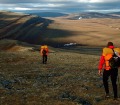In recent years, barefoot shoes have become increasingly popular as they promote natural walking and offer numerous health benefits. These specialized shoes are characterized by a thin, flexible sole that allows the foot to move freely and maintain close contact with the ground.
Overview of the Nervous System
The nervous system, consisting of the central and peripheral nervous systems, controls many vital functions in the body. It is responsible for sensory perception, movement control, and regulation of internal organs. The nervous system plays a crucial role in processing stimuli received by the foot while walking.
Anatomy and Function of the Foot
Foot Structure and Movement Mechanics
The human foot consists of 26 bones, 33 joints, and more than 100 muscles, tendons, and ligaments. This complex structure not only enables flexible movement but also provides excellent shock absorption and balance. The foot plays a key role in posture and locomotion.
Sensory Functions of the Foot
The soles of the feet are densely packed with nerve endings that act as sensors. These sensory receptors help the nervous system gather information about the environment, such as surface texture, temperature, and pressure distribution. These signals are sent to the brain to adjust posture and movements.
What Are Barefoot Shoes?
Barefoot shoes have a minimalist design that simulates the feeling of walking barefoot. They feature an extremely thin, flexible sole with no heel, allowing for natural foot movement. The shoe adapts to the shape of the foot without restricting it.
Differences from Traditional Shoes
Unlike traditional shoes, barefoot shoes offer minimal support or cushioning. Traditional shoes often support the arch and cushion steps, while barefoot shoes allow the foot to work naturally, thus activating the nervous system more effectively.
The Role of the Nervous System
Sympathetic and Parasympathetic Nervous Systems
The autonomic nervous system consists of two main parts: the sympathetic system, which activates the body in stressful situations, and the parasympathetic system, responsible for relaxation and recovery. Both systems must be in balance for healthy function.
Connection Between Foot and Brain
The nerve endings in the feet continuously send signals to the brain, allowing it to adjust posture and movement. This is a key part of proprioception, which helps us perceive the position and movement of our body in space.
How Barefoot Shoes Affect the Nervous System
Activation of Foot Sensors
Wearing barefoot shoes enhances direct contact between the foot and the ground, activating the foot’s sensors. This leads to a heightened awareness of the environment and improves the nervous system’s responsiveness.
Improvement of Proprioception
Proprioception, or the body’s ability to perceive its position in space, is improved by wearing barefoot shoes. Without the cushioning of traditional shoes, the nervous system must work harder to maintain balance and coordinate movements.
Promotion of Neural Adaptability
The nervous system constantly adapts to new stimuli. Barefoot shoes challenge this adaptability, as the foot’s sensors are exposed to constantly changing surfaces, leading to improved neural plasticity.
Health Benefits
Improved Posture and Balance
Barefoot shoes promote a natural posture and strengthen the foot muscles. This contributes to better balance and overall body stability.
Reduction of Stress and Anxiety
The enhanced sensory feedback from the feet can calm the autonomic nervous system and reduce stress. Studies show that people who walk barefoot regularly experience less anxiety and stress symptoms.
Better Circulation and Joint Health
Since barefoot shoes promote foot mobility, blood circulation is improved, which helps nourish the joints. This can contribute to the long-term prevention of joint diseases.
Potential Drawbacks and Challenges
Adjustment Period and Muscle Soreness
Transitioning to barefoot shoes may initially cause muscle soreness as muscles that are underutilized in traditional shoes are activated. A gradual introduction can help minimize this effect.
Lack of Cushioning on Hard Surfaces
Since barefoot shoes offer little cushioning, walking on hard surfaces can put strain on the joints. In such cases, it’s important to focus on proper technique.
Practical Tips for Transitioning
Slow Integration into Daily Life
To avoid injury, barefoot shoes should be gradually integrated into daily life. Start with short walks and gradually increase the duration of wear.
Choosing the Right Barefoot Shoes for Different Activities
There are various models of barefoot shoes for different activities such as running, hiking, or everyday use. It’s important to choose the right shoe for the specific activity to maximize the benefits.
Conclusion
Summary of Key Points
Barefoot shoes offer numerous health benefits, particularly in relation to the nervous system. They promote natural foot movement, enhance sensory perception, and support healthy posture.
Final Thoughts and Recommendations
Those looking for a natural way to improve their health should consider barefoot shoes. A gradual transition can help fully harness the many benefits.











